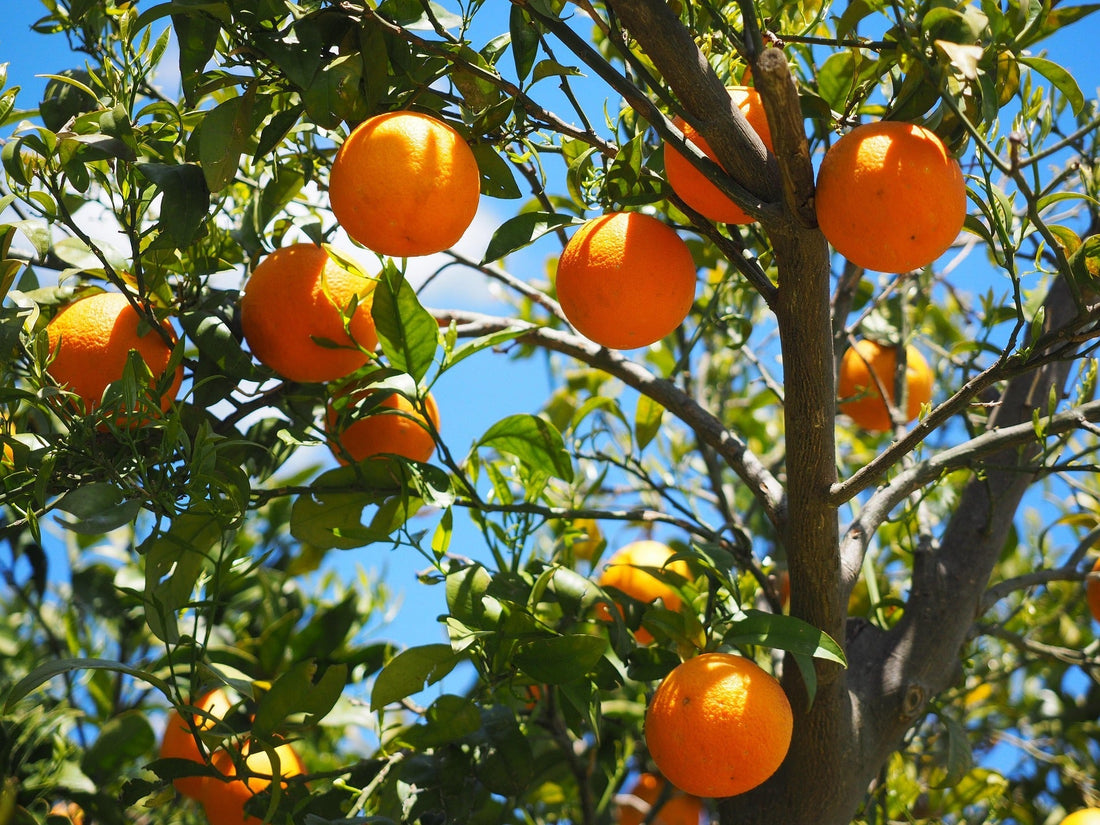Oranges are a cornerstone of Mediterranean culture, particularly in France and Italy, where they thrive in sun-drenched orchards. From the sweet, juicy Tarocco of Sicily to the bitter Seville oranges lining the streets of Menton, these citrus fruits are not only delicious but also steeped in history and tradition.
The Many Varieties of Oranges
Oranges come in many forms, each with its own distinct characteristics:
- Tarocco (Italy) – A blood orange from Sicily, known for its high vitamin C content and deep red flesh.
- Moro (Italy) – Another blood orange, even darker than Tarocco, with a rich, berry-like flavour.
- Sanguinello (Italy & Spain) – The third blood orange variety, commonly grown in Spain but also found in southern Italy.
- Seville (Spain & France) – A bitter orange used mainly for marmalade and liqueurs.
- Valencia (Italy & Spain) – One of the juiciest oranges, perfect for fresh juice.
- Navel (Italy & France) – Sweet, seedless, and easy to peel, making it a favourite for eating fresh.
- Bergamot (Italy) – A highly aromatic citrus used in perfumes, Earl Grey tea, and some Italian liqueurs.
The Magic of Blood Oranges
Blood oranges, particularly the Tarocco, Moro, and Sanguinello varieties, are among the most distinctive citrus fruits in the world. Their deep red flesh develops due to anthocyanins, a type of antioxidant that forms in response to the cold nights and warm days of Mediterranean winters. While the Tarocco is the sweetest and juiciest, the Moro has the deepest colour and a rich, almost berry-like taste. The Sanguinello, with its balanced sweetness and acidity, is prized for both juicing and fresh eating. These oranges are not only delicious but also incredibly nutritious, packed with vitamin C and powerful antioxidants that have been linked to numerous health benefits. Blood oranges are a staple in Sicilian cuisine, featuring in everything from salads with fennel and olives to granita and candied orange peels. Their vibrant colour and unique flavour make them a winter delicacy, celebrated across Italy and beyond.
The Unique Charm of Mandarins
Mandarins, often mistaken for small oranges, are actually a distinct citrus species with their own unique characteristics. Unlike standard oranges, mandarins have thinner, looser skins, making them incredibly easy to peel by hand. Their flavour is sweeter and less acidic, with varieties like Clementine, Satsuma, and Tangerine being particularly popular in France and Italy. Clementines, a hybrid of mandarins and sweet oranges, are widely cultivated in Corsica and Calabria, where they develop an intense aroma and seedless flesh. Satsumas, originally from Japan but now grown in the Mediterranean, are among the most delicate and juicy mandarins, often found in festive winter markets. Tangerines, slightly more tart and fragrant, are commonly used for essential oils and liqueurs. Unlike many oranges, mandarins tend to ripen earlier in the season, making them a cherished fruit in late autumn and winter. Their versatility extends beyond fresh eating—they’re often used in desserts, salads, and even savoury dishes, where their natural sweetness complements everything from roasted meats to dark chocolate.
The Fragrant World of Bergamot
Bergamot, a small citrus fruit primarily grown in Calabria, Italy, is one of the most sought-after ingredients in the world of fine perfumery. Unlike sweet oranges, bergamot has a uniquely intense, floral-citrusy aroma, making it a favourite among luxury perfume houses such as Guerlain, Dior, and Chanel. It is a key note in many iconic fragrances, including the classic Eau de Cologne and contemporary blends where it lends a fresh, sophisticated brightness. The essential oil is extracted from the fruit’s rind through a delicate cold-pressing process to preserve its complex scent. Beyond perfumery, bergamot is famously used to flavour Earl Grey tea and features in various liqueurs and confectionery. At SOAPYARD.com, bergamot’s vibrant, aromatic essence is captured in artisan French-milled soap, offering a refreshing and uplifting scent reminiscent of Mediterranean citrus groves.
The Forbidden Fruit of Menton
Menton, on the French Riviera, is famous for its annual Fête du Citron (Lemon Festival), but its streets are also lined with orange trees. These oranges, however, are not meant to be eaten! The ornamental trees bear bitter fruit, primarily used for decoration and marmalade. Tourists are often tempted to pick them, only to discover their extreme bitterness.
Twice a Year? The Curious Fruiting of Citrus
Unlike many fruits that have a single harvest season, some oranges can bear fruit twice a year, especially in Mediterranean climates. This phenomenon is most common in the Valencia variety, which can produce both spring and late-summer harvests, ensuring an almost continuous supply of fresh juice.
The Many Uses of Oranges
Oranges are incredibly versatile. Some of their most common uses include:
- Fresh eating – Navel and Tarocco oranges are best for eating as they are sweet and seedless.
- Juicing – Valencia oranges dominate the juice industry thanks to their high juice content.
- Cooking – Bitter Seville oranges are essential for marmalade and some traditional dishes.
- Perfumes & Essential Oils – Bergamot oranges from Calabria are prized in the fragrance industry.
- Liqueurs & Cocktails – Oranges are used in drinks like Grand Marnier, Cointreau, and Italian Aperol Spritz.
Classic Orange Recipes to Try
Here are some timeless orange-based recipes:
- Marmalade – A traditional way to preserve the tangy flavour of bitter oranges. BBC Good Food’s Seville Orange Marmalade
- Arancello – A lesser-known cousin of limoncello, made with orange zest. Learn how to make it here
- French Orange Tart (Tarte à l’Orange) – A delicious dessert featuring a citrus-infused custard. Try this recipe
- Duck à l’Orange – A classic French dish combining citrus and savoury flavours. Find an authentic recipe
The Orange Harvest in February: A Citrus Abundance
February is peak orange season in the Mediterranean, with market stalls overflowing with fresh citrus. This abundance is why freshly squeezed orange juice is so common in Italian and French cafés at this time of year. If you visit Sicily or Provence in winter, don’t miss the chance to taste oranges at their absolute best!
Further Reading & Resources
- Citrus Growers Forum: https://citrusgrowersv2.proboards.com
- Fête du Citron in Menton: https://www.fete-du-citron.com
- The Slow Food Ark of Taste – Blood Oranges of Sicily: https://www.fondazioneslowfood.com/en/ark-of-taste-slow-food/sicilian-blood-orange/
- The Bergamot Consortium of Calabria: https://www.consorziobergamotto.it

